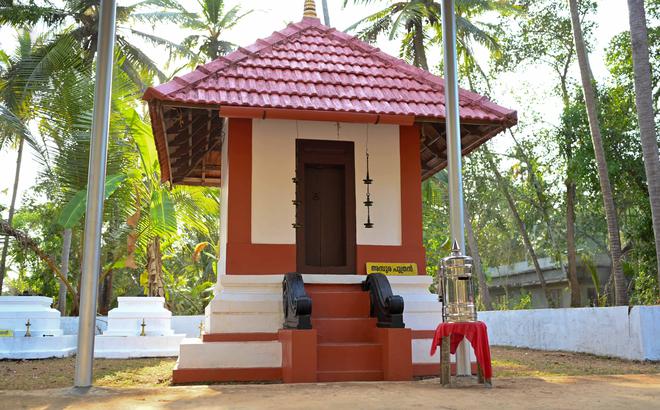
North Kerala is neither short of heroes nor hero worship, the Vadakkan Pattukal (Ballads of the North) being the source for the steady supply of war heroes.
Rayarappan Nambiar is no warrior but a tiger hunter whose legacy is alive more than two centuries after his death not just through ballads but a temple as well as a ‘Thira’ to his name.
‘Theyyam’ and ‘Thira’ are somewhat similar ritualistic art forms of northern Kerala often performed in temples and sacred groves. Thousands are drawn to these performances during the Theyyam season from December to April, a testament to the extent of hero worship in the folklore heartland.
As for Rayarappan Nambiar, while the ballads on him faded over time, the legend has been kept alive through the Thira which recreated the oral ballads visually. Now, an archaeological anthropologist N.K. Ramesh traces the history of tiger hunting that happened in Thalassery, Kannur, along with the background associated with hero worship in the ritual performances through his book Kattodi Rayarappan Nambiar; Kadathanadan Puliyankam released recently.
“There was a time when hunting was a profession with good remuneration in many parts of the State. Rayarappan Nambiar, though quite young, was an accomplished tiger hunter who saved the region from many an animal attack,” says Mr. Ramesh.
Legend has it that the British ruler of Thalassery in the 19th Century was worried by the constant wildlife attacks in the region and brought in Nambiar from Kattodi, Kozhikode, to hunt the tigers down. Nambiar demanded 41 gunmen to assist him. But when the tiger attacked, all of them fled leaving Nambiar alone to fight the animal. He was injured in the fight but managed to succeed in his mission. He returned to the Thalassery fort with the tiger’s tail and tongue as mementos and the ruler gifted Nambiar’s family with land and government jobs. Unfortunately, Nambiar breathed his last at Nadapuram, en route home.
The Nambiar Theyyam, performed at Kattodi Meethal Temple every year on the night after Sivaratri, emerged much later after his death. The story is that Nambiar appeared in his brother’s dream demanding that his Thira (Theyyam) be performed.
As Nambiar got a Theyyam incarnation, so did the tiger, his nemesis. ‘Pulichamundi’ (Vishnumoorthi) shares the centre stage with Nambiar (Asuraputhran) throughout the performance in which they re-enact the battle.
“Like most folklore characters of north Kerala, the Nambiar and Pulichamundi Theyyams too have undergone sanskritisation over a period of time. Hence, the folk characters, who are part of history, have been mixed up with mythical characters. This has mainly affected the costumes and names of the characters but the story is untouched,” says Mr. Ramesh, explaining the names ‘Asuraputhran’ and ‘Vishnumoorthi’.
Kattodi Meethal Temple was set up by the successors of Nambiar, who still helms the temple trust. The family as well as the community surrounding the temple play an active role during the performance. “The local people have great faith and respect for Rayarappan Nambiar and they turn up for the Thira in thousands. In fact, some sections of the community have specific roles in the event,” says Gangadharan Nambiar, a temple trustee.
The festival procession begins from the street beside the temple occupied by the Chaliya (weavers) community, which has the right to declare the festival open. The Velan and Malayan communities perform the Nambiar Theyyam and the Pulichamundi respectively. The Veluthadan community (launderers) still holds the right to contribute the clothes of the Thira. The Kollans (blacksmiths) provide the weapons. As for the Nambiars, elder members of the family accompany the Nambiar Theyyam, as it takes centre stage, carrying spear, sword and the golden dagger that are part of the deity’s armour.
“Most members of these communities do not practise their traditional professions these days. Many of them have high paying jobs and are even settled abroad. But they consider it their family’s right to perform their roles in connection with the Thira and make it a point to be part of the festivities every year,” says Gangadharan Nambiar.
Like the Nambiar Theyyam, several of the Theyyam and Thira characters are hero-worshipped across northern Kerala. They are examples of how ritualistic performances keep alive ballads of legends that had lost their social structure over time. They are also instances of heroes being made immortal through the masses.







